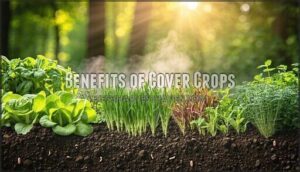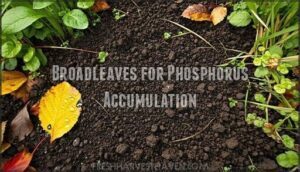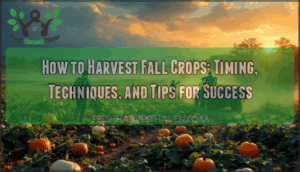This site is supported by our readers. We may earn a commission, at no cost to you, if you purchase through links.
 Fall garden cover crops transform your empty vegetable beds into soil-building powerhouses during winter’s quiet months.
Fall garden cover crops transform your empty vegetable beds into soil-building powerhouses during winter’s quiet months.
You’ll plant these hardworking crops after harvesting summer vegetables, typically in late August through September.
They prevent erosion, suppress weeds, and add organic matter while you’re not actively gardening.
Nitrogen-fixing legumes like crimson clover team up with winter rye grass to create the perfect soil partnership.
These seasonal workers break up compacted earth, feed beneficial microorganisms, and set the stage for explosive spring growth.
The right cover crop selection and timing can make the difference between struggling plants and thriving harvests.
Table Of Contents
- Key Takeaways
- Fall Garden Preparation
- Benefits of Cover Crops
- Types of Cover Crops
- Planting Cover Crops
- Managing Cover Crops
- Frequently Asked Questions (FAQs)
- What is the best cover crop to plant in fall?
- What cover crops can be planted in October?
- What are winter cover crops for gardens?
- What is the easiest cover crop to terminate?
- How do cover crops affect water conservation?
- Can cover crops attract or deter specific pests?
- What tools simplify shredding and incorporating cover crops?
- Are there cover crops suitable for container gardens?
- How do cover crops influence soil pH over time?
- Can cover crops survive harsh winter temperatures?
- Conclusion
Key Takeaways
- Match cover crops to your specific climate – Choose winter rye for cold zones down to -30°F, crimson clover for mild areas, and drought-resistant varieties like pearl millet for dry regions to ensure successful establishment and winter survival.
- Plant at the right time for maximum benefits – Sow cover crops at least 30-45 days before your first expected frost date to allow proper establishment, with legumes needing 60 days and faster crops like buckwheat requiring only 30 days.
- Select crops based on your soil’s needs – Use nitrogen-fixing legumes like hairy vetch to boost fertility, grasses like winter rye for erosion control, and taproot crops like oilseed radishes to break up compacted soil naturally.
- Terminate cover crops properly for spring success – Cut crops at full bloom before they set seed, chop into small pieces, and incorporate immediately into soil 2-3 weeks before spring planting to maximize nutrient release and prevent reseeding issues.
Fall Garden Preparation
You’ll need to assess your soil, climate, and garden goals before choosing the right cover crops for fall.
Careful preparation now guarantees your soil stays healthy, reduces weeds, and supports next season’s growth, which is a complete concept that ensures your garden remains productive.
Choosing Right Cover Crops
To get the most out of your fall cover crops, you’ve got to match the right plants to your garden’s needs and growing conditions.
Don’t just grab any seed packet—think about what your soil and space need most.
Here’s what to keep in mind for smart cover crop selection:
- Climate suitability for fall planting guide success
- Space availability for garden cover crops to thrive
- Primary goals like weed suppression or nitrogen fixing
- Thriving season and timing for cover crop types
- Specific needs such as erosion control or soil structure improvement
Soil Preparation Techniques
Think of your garden soil as the canvas for your fall masterpiece.
Your fall garden deserves the same care as a painter choosing the perfect canvas.
Start by clearing out weeds, then use tilling methods to loosen compacted spots—this helps with drainage improvement and root growth.
Do a quick pH testing; aim for a range of 6–7 for most cover crops.
Mix in soil amendments like compost to boost organic matter and structure.
Fall application allows soil pH adjustments to take effect over the winter.
Break up big clumps and rake the surface smooth for even seed-to-soil contact.
Careful garden soil preparation now means easier soil improvement and healthier crops come spring—your future self will appreciate the effort to create a healthier environment with better drainage and improved soil structure for optimal growth.
Climate Considerations
In the context of fall cover crops, matching your choices to your region’s climate is key.
Regional suitability, frost tolerance, and water availability all shape your options.
Here’s what you’ll want to keep in mind:
- Winter rye stands strong in cold-weather gardening, handling temperatures down to -30°F.
- Crimson clover thrives in mild climate gardening with minimal rainfall.
- Buckwheat’s short growing season means it succumbs at the first frost, while winter cover crops like cereal rye shrug off snow and cold.
Benefits of Cover Crops
When you plant cover crops in your fall garden, you protect the soil from erosion, boost fertility, and suppress weeds all at once.
These crops add organic matter, improve soil structure, and support beneficial insects, helping your garden thrive through winter and into spring with complete concepts.
Soil Erosion Prevention
Once your fall garden beds are ready, it’s time to shield them from winter’s worst.
Fall cover crops work like a living blanket, locking soil in place and stopping wind erosion and water runoff.
Their strong root systems hold soil tight, offering slope stabilization and fighting soil compaction.
Even on a breezy hillside, garden cover crops keep your topsoil where it belongs—right under your feet.
Here’s a quick look at how cover crops help with erosion prevention:
| Problem | Solution | Benefit |
|---|---|---|
| Wind Erosion | Root Systems | Erosion Control |
| Water Runoff | Slope Stabilization | Erosion Prevention |
| Soil Compaction | Fall Cover Crops | Healthier Soil |
This approach ensures that your garden remains protected and healthy throughout the winter months.
Improving Soil Fertility
After protecting your soil from erosion, fall cover crops step up as powerful soil amendments. These garden cover crops act like green manure, breaking down over winter and feeding your soil with organic matter.
As they decompose, they release nutrients right where your spring veggies need them most. Legumes are stars at nitrogen fixation, pulling nitrogen from the air and making it available for your next crop.
This process boosts soil fertility and supports healthy nutrient cycling. To maximize these benefits, consider how soil microorganisms communities are supported by drought-tolerant varieties.
Here’s what you’ll love:
- Improved soil structure and water retention.
- Increased microbial activity for better nutrient use.
- More available nitrogen thanks to nitrogen fixation.
- Soil that’s ready to support strong, healthy plants come spring.
Enhancing Biological Activity
After boosting soil fertility, let’s talk about what’s happening beneath the surface.
Cover crops spark an explosion of microbial biodiversity, feeding soil microorganisms with fresh organic matter. This activity builds a strong soil foodweb, where beneficial organisms thrive and nutrient cycling speeds up.
Earthworms and mycorrhizal fungi flourish, especially when you use leguminous cover crops for nitrogen fixation.
The result? Improved soil health, more resilient gardens, and a living system ready to support spring’s next crop.
Weed Suppression Methods
After boosting soil life, it’s time to tackle weeds head-on.
Fall cover crops are like your garden’s living mulch, crowding out weeds before they get a chance. Dense plantings, such as winter rye, use smother cropping to block sunlight and stop weed seeds from sprouting.
Some garden cover crops, like certain allelopathic plants, even release natural chemicals—Allelopathic Effects—that make life tough for weeds.
This means less weed competition and reduced herbicides come spring. Try blends for stronger weed suppression and consider these as reliable mulch alternatives for smart weed management.
Types of Cover Crops
You’ll find several main types of cover crops, each offering unique benefits for your fall garden.
Understanding legumes, grasses, broadleaf plants, and taproot crops helps you choose the best options to improve soil health and manage weeds effectively.
Legumes for Nitrogen Fixation
If you want to give your soil a natural boost, nitrogen-fixing legumes are your secret weapon.
These nitrogen-fixing plants work with soil microbes, turning air into plant food while you rest.
When you choose superior species like crimson clover or hairy vetch, you’re setting up your garden for better nitrogen availability come spring.
Inoculation methods for legume seeds help guarantee strong partnerships with soil bacteria.
After winter, legume decomposition releases nutrients right where your crops need them.
Here are four standout options:
- Hairy vetch – reliable nitrogen-fixing and winter-hardy
- Crimson clover – vibrant blooms, great for companion planting
- Field peas – fast growth, easy to manage
- Red clover – perennial soil builder
Grasses for Soil Structure
If legumes are your soil’s chefs, then grassy cover crops are the construction crew.
Grasses like winter rye, winter wheat, oats, and barley build root biomass that acts as nature’s tiller, breaking up compaction and improving water infiltration.
Their fibrous roots lock soil in place, offering exceptional erosion control through winter.
Grass selection matters—choose what fits your climate and needs.
Here’s a quick look:
| Grass Type | Key Benefit |
|---|---|
| Winter Rye | Erosion control |
| Barley | Compaction reduction |
| Annual Ryegrass | Water infiltration |
The choice of grass is critical for achieving specific benefits, such as compaction reduction and improving water infiltration.
Broadleaves for Phosphorus Accumulation
With broadleaf cover crops like buckwheat and phacelia, you can turn your soil into a phosphorus gold mine.
Their roots release organic acids, boosting phosphorus availability for your next crops. Smart broadleaf selection matters—species like Polygonum can release up to 15% of soil phosphorus.
Mycorrhizal associations help too, extending roots and improving nutrient cycling. These fall cover crops thrive at the right soil pH and return organic phosphorus as they decompose.
That means more soil nutrients and better cover crop benefits for your garden, ultimately leading to a more sustainable approach.
Taproot Crops for Compacted Soil
If your soil feels like a brick after summer, taproot crops can help. These plants, like oilseed radishes and mustards, send deep taproots through tough layers, tackling soil compaction head-on. Think of them as nature’s jackhammers—quiet, but effective.
Here’s what they do:
- Boost soil aeration and Subsoil Drainage
- Pull nutrients up from deep layers (Nutrient Mining)
- Improve Root Penetration for future crops
- Enhance soil structure without heavy equipment
Taproot crops make compaction alleviation simple and natural. They also improve water infiltration, further enhancing soil health.
Planting Cover Crops
When you plant cover crops in fall, you’ll need to pay close attention to seed types, timing, and how deep you sow each variety.
Careful planning guarantees your garden gets the most benefits, from soil improvement to weed control, before spring planting begins.
Seeding Rates and Depths
Picking the right cover crop seeds is just the start—how you plant makes all the difference.
Seed Size, Soil Type, and Ideal Spacing matter for strong seed establishment.
Small seeds like clover need shallow planting (¼ inch), while rye prefers ½–1 inch deep.
Always use a broadcast spreader or hand-sow, then rake lightly for better germination rates.
Many gardeners find success with bulk clover options.
Check out this quick guide:
| Seed Type | Seed Depth | Rate per 1,000 sq ft |
|---|---|---|
| Clover | ¼ inch | 2–3 lbs |
| Rye | ½–1 inch | 1–4 lbs |
The key to a successful cover crop is in the details of planting, including the depth and spacing of the seeds, as well as the type of spreader used.
Using the right techniques can significantly improve the health and productivity of the crop.
Inoculation for Legume Seeds
Success hinges on matching your legume crops with the right rhizobia bacteria through proper inoculation. These nitrogen-fixing bacteria form partnerships with legume roots, transforming atmospheric nitrogen into plant-available nutrients.
Without inoculation, you’re missing out on nature’s free fertilizer factory. For those seeking to purchase, consider exploring options for legume inoculant products.
Essential application methods guarantee maximum enhanced fixation:
- Seed coating: Mix inoculant types with water to create a slurry before planting
- Powder dusting: Sprinkle dry inoculant directly onto moistened seeds for even coverage
- Liquid application: Use commercial liquid nitrogen-fixing bacteria solutions for larger areas
Store inoculants properly in cool conditions to keep these living organisms viable until planting time.
Planting Timing and Techniques
Timing your fall cover crops correctly sets the foundation for next season’s success.
Plant at least 30 days before your expected frost date, allowing adequate establishment time for seasonal planting benefits.
| Cover Crop | Frost Date Timing | Planting Depth | Soil Temperature | Watering Needs |
|---|---|---|---|---|
| Winter Rye | 30-45 days before | 0.5-1 inch | 50-65°F | Moderate |
| Crimson Clover | 60 days before | 0.25-0.5 inch | 60-70°F | Regular |
| Buckwheat | 30 days before | 0.5 inch | 45-65°F | Light |
| Oats | 45 days before | 1-1.5 inches | 40-60°F | Moderate |
| Hairy Vetch | 60 days before | 0.5-1 inch | 50-70°F | Regular |
Proper seedbed prep involves loosening the top 3-4 inches of soil and creating an even surface.
Plant seeds at depths roughly three times their width in sandy soil, twice in heavier soils.
Keep your garden cover crops consistently moist until germination occurs.
Seed Selection for Specific Climates
Your climate zone determines which garden cover crops will thrive through winter.
Winter rye survives brutal -30°F temperatures in USDA Hardiness Zones 3-5, while sunn hemp flourishes in zones 8-11’s warmth.
Regional varieties adapted to local conditions outperform generic seeds every time.
Consider these climate-specific selections for your fall cover crops:
- Cold climates: Choose winter rye and hairy vetch for reliable frost tolerance
- Warm regions: Plant sunn hemp and cowpeas for heat-loving winter cover crops
- Wet areas: Select red clover and cereal rye for saturated soil performance
- Dry zones: Use pearl millet and daikon radish for drought-resistant coverage
- Microclimate selection: Match less hardy species to sheltered garden spots
Check with local suppliers for cover crop mix varieties already proven in your area’s unique growing conditions.
Managing Cover Crops
Once your cover crops reach maturity, you’ll need to properly manage them to maximize their soil benefits.
The key is timing your incorporation correctly – too early and you lose potential growth, too late and they become difficult to work into the soil.
Digging in Cover Crops
Cut your fall cover crops when they reach full bloom but before they set seed.
Chop plants into small pieces using a mower or garden shears to speed decomposition rate. This green manure breaks down faster when shredded, releasing nutrients quickly.
Incorporation timing matters—dig garden cover crops into soil immediately after cutting.
Proper soil disturbance helps planting cover crops decompose efficiently, boosting soil health through faster nutrient release without heavy equipment needs.
Tillage and Incorporation Methods
Once you’ve grown healthy garden cover crops, proper soil incorporation becomes your next priority. Tillage timing affects decomposition rates and nutrient release substantially.
Here are five effective tilling under methods for soil incorporation:
- Spring Mowing – Cut growth 2-3 weeks before planting, allowing natural breakdown
- Disk Harrowing – Chop and mix residue management into top soil layers
- No-till options – Crimp or roll cover crops, plant directly through green manure
- Rotary Tilling – Complete seed termination through deep soil mixing
- Strip Tillage – Till narrow bands while preserving soil structure between rows
Equipment needs vary by garden size and cover crop density. Selecting the right tillage tools is vital for effective soil management.
Preventing Reseeding and Weed Growth
Before your fall garden cover crops turn into unwanted guests, focus on timely termination and smart mowing strategies to stop reseeding.
Watch bloom timing—early mowing halts seed viability.
Winter-kill crops help with natural seed termination and weed suppression.
Rye’s allelopathic effects add another layer of weed control.
Stay proactive and your garden stays trouble-free.
Evaluating Garden Needs for Cover Crops
Before choosing garden cover crops, you’ll need soil testing to determine pH and nutrient levels.
Consider space availability—cramped beds require compact varieties like crimson clover. Goal prioritization matters: legumes boost soil fertility, while grasses prevent erosion.
Budget constraints affect seed selection, and equipment access influences planting methods. Match your organic gardening goals with sustainable agriculture practices for ideal soil health results.
To further enhance the soil, consider how nitrogen-fixing crops enrich the earth.
Frequently Asked Questions (FAQs)
What is the best cover crop to plant in fall?
Annual ryegrass establishes in just 4-6 weeks before frost, making it your top fall choice. You’ll get excellent erosion control, weed suppression, and it decomposes easily for spring planting schedules.
What cover crops can be planted in October?
In October, you can plant winter rye, crimson clover, annual ryegrass, oats, hairy vetch, and Austrian winter peas. These cold-hardy varieties establish well before frost hits.
What are winter cover crops for gardens?
Winter cover crops protect your soil during cold months while adding nutrients and organic matter.
You’ll plant hardy varieties like winter rye, crimson clover, and hairy vetch that survive freezing temperatures and benefit next season’s garden.
What is the easiest cover crop to terminate?
Ironically, buckwheat’s your best friend here—it’ll freeze and die at just 32°F, basically terminating itself.
You won’t need heavy equipment or backbreaking work since winter naturally handles the job for you.
How do cover crops affect water conservation?
Cover crops boost water conservation by improving soil structure and adding organic matter, which increases the soil’s ability to absorb and retain moisture while reducing runoff and evaporation.
Can cover crops attract or deter specific pests?
Smart gardeners know that specific cover crops work like natural pest management tools.
You’ll find that some species attract beneficial insects while others naturally deter harmful pests through their unique properties and chemical compounds, making them act like beneficial insects.
What tools simplify shredding and incorporating cover crops?
A sharp spade easily chops through cover crop stems, while a string trimmer or brush cutter quickly shreds growth before tilling the organic matter into your soil.
Are there cover crops suitable for container gardens?
You can definitely grow cover crops in containers! Choose compact varieties like crimson clover, buckwheat, or annual ryegrass. They’ll improve your potting soil’s health and suppress weeds effectively.
How do cover crops influence soil pH over time?
Different cover crops affect soil pH in various ways over time.
Legumes like clover typically maintain neutral pH, while grasses can slightly acidify soil as they decompose and release organic acids.
Can cover crops survive harsh winter temperatures?
Yes, many cover crops can survive harsh winters.
Winter rye tolerates temperatures down to -30°F, while crimson clover handles 10°F.
Choose cold-hardy varieties like hairy vetch and Austrian winter peas for reliable winter survival.
Conclusion
Success breeds success in the case of fall garden cover crops – these seasonal guardians will transform your tired soil into next year’s foundation for flourishing plants.
You’ve learned how proper timing, species selection, and management techniques create healthier gardens with less work.
Your fall garden cover crops investment pays dividends through improved soil structure, reduced weeds, and enhanced fertility. Start planning your cover crop strategy now to reap the rewards come spring planting season.












